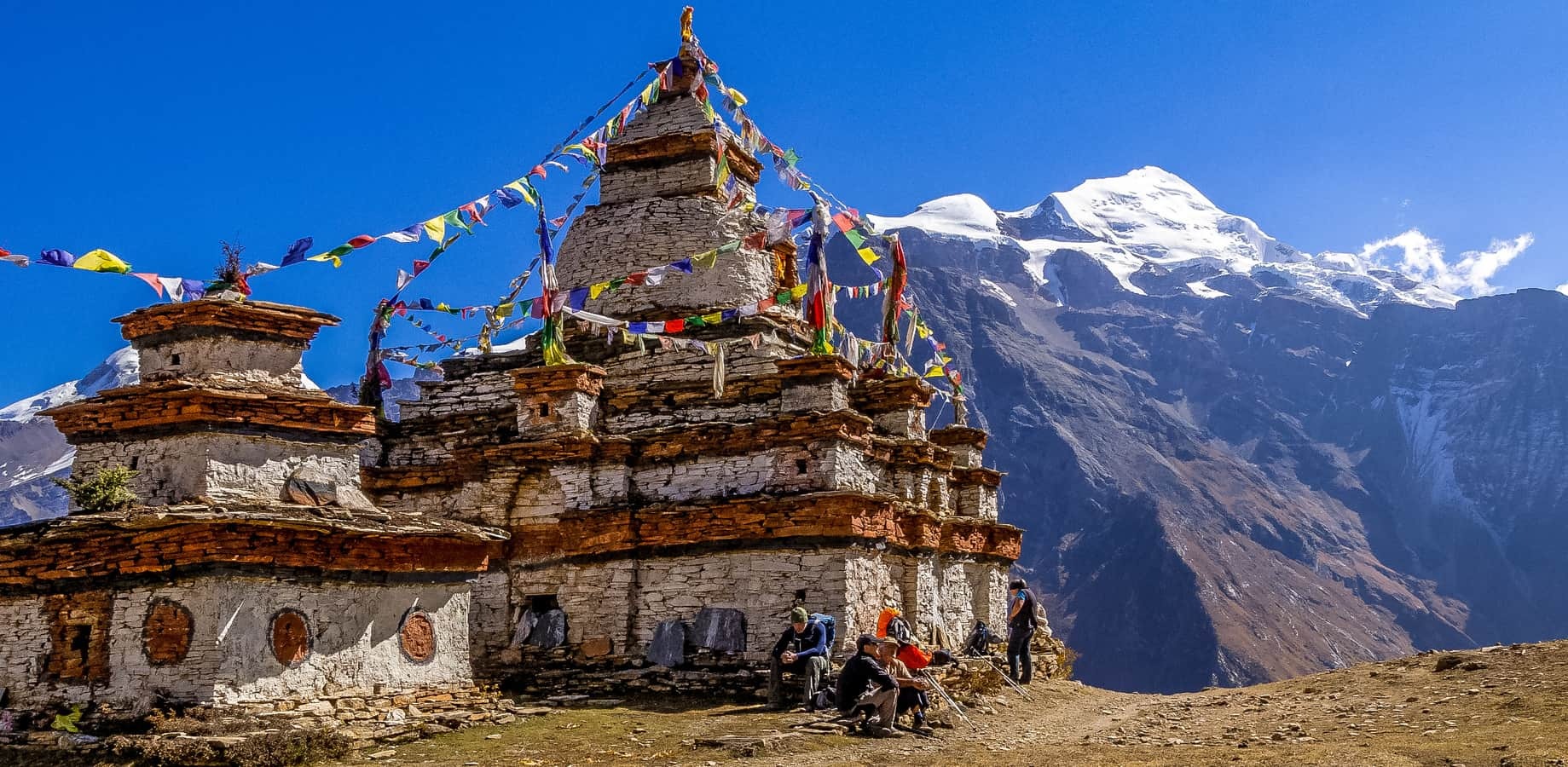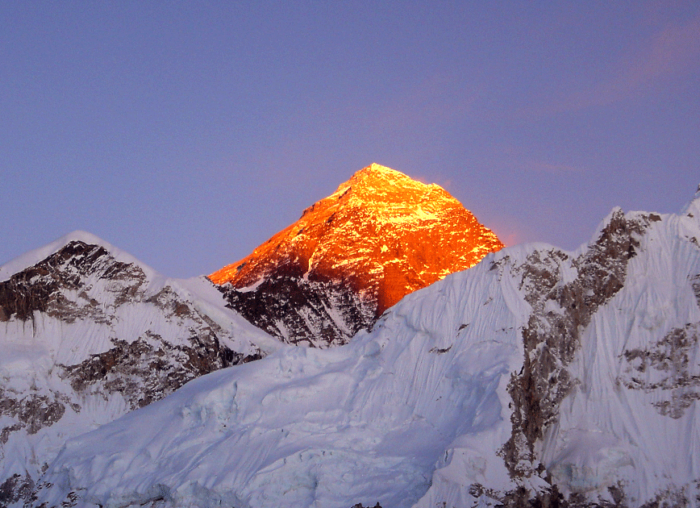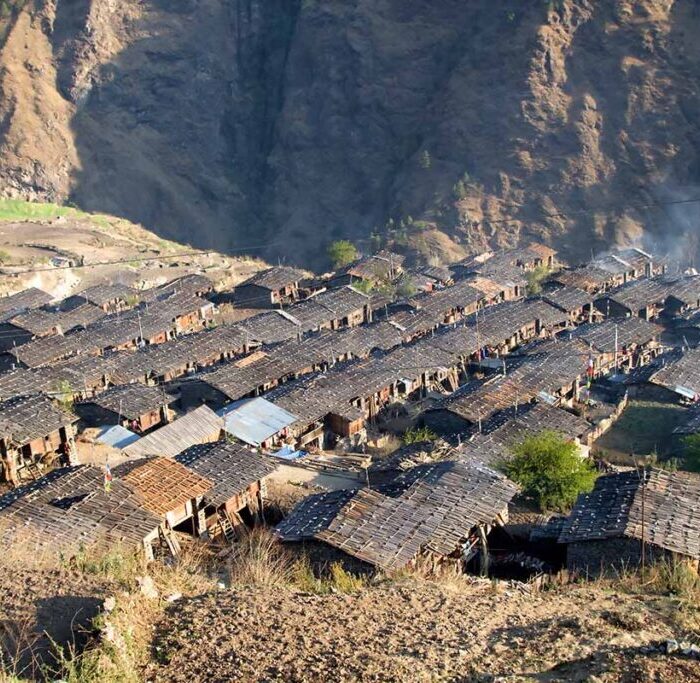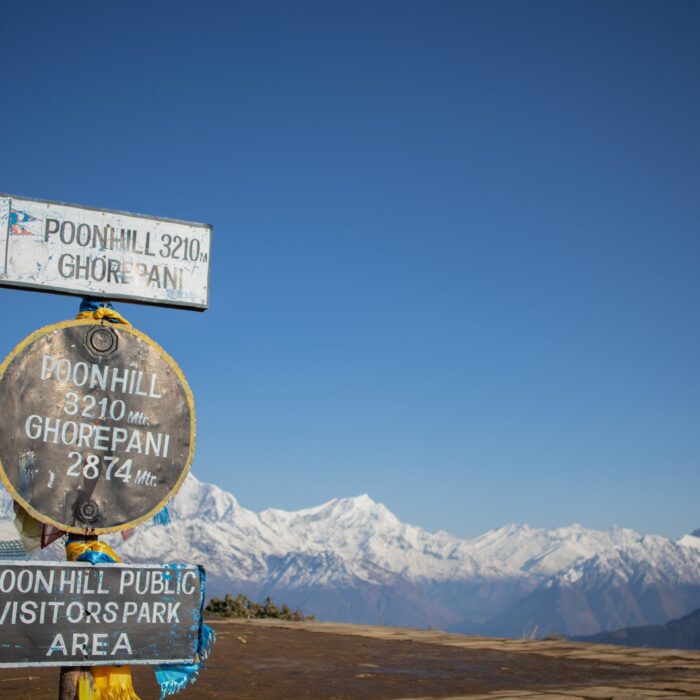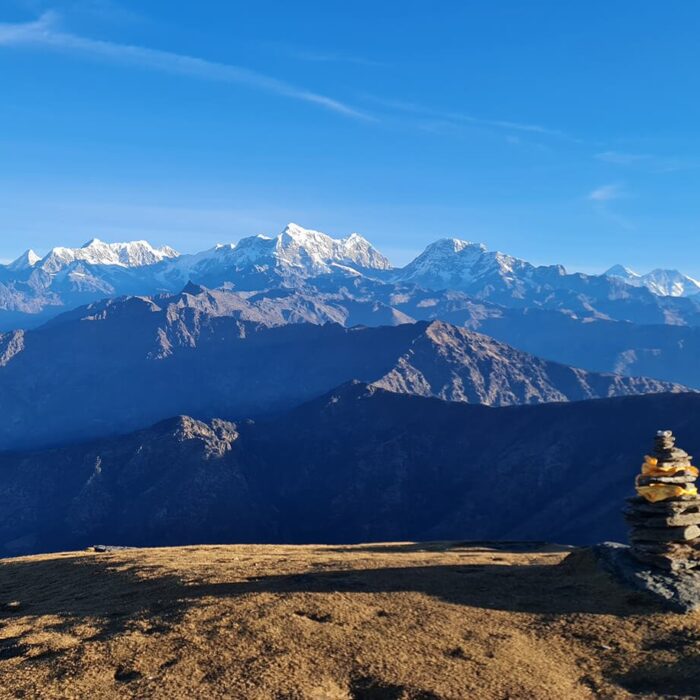The Nar Phu 16-day trek is like finding a hidden treasure behind the grand Himalayan Mountains. It’s also known as the “Kang La Pass” trek, perfect for adventure lovers seeking something different in Nepal. Unlike the busy trails of popular treks, this place stands out for its great natural beauty, ancient Tibetan culture, and nice atmosphere. Nar and Phu are two valleys in the Annapurna region, and diving the Nar Phu 16-day trek takes you to less seen destinations. The Nar Phu trek route includes spots where you can witness the grand Himalayan Mountains up close.
Unveiling the Charms of Nar Phu Valley
Nar Phu Valley is a dream come true for hikers worldwide. It features tall peaks, icy fields, remote villages, narrow canyons, forests, rock formations, yaks, grassy fields, and Tibetan cultures. The Nar Phu trek lasts about 16 days, going up to heights of 5320 meters. Along the way, the hikers will enjoy great views of bold mountains like Mt Manaslu, Mt Dhaulagiri, Mt Annapurna I, and over 19 snowy peaks in the Annapurna region. The trek has diverse landscapes and offers nice views and opportunities to immerse in local customs.
Alpine Lifestyle and Unique Features
People who love climbing truly value the mountain way of life for its natural beauty. They find it lovely due to the tribal people and their ancient traditions. The Highlanders establish special villages for summer and winter. They also maintain lush fields where their animals graze. These aspects add an extra layer of rarity and charm to the trek.
Changing Landscapes and Atmosphere
As you start walking on the Nar Phu Valley trail, excitement fills the air. As you trek, you’ll notice the areas turning from green valleys to dry landscapes. In the lower part, green forests, and lush plants abound. Higher up, you’ll see deep gorges, top cliffs, and challenging parts. Thus, creating a constantly changing scenery with each step. You can hear rivers flowing in the distance. It provides a pleasant background sound as you explore further in this hidden paradise.
Less Crowded Trekking Trail
If you want a trek where there aren’t too many people, then the 16-day Nar Phu Trek is just right. The pretty villages with Buddhist flags give you a look at the lively culture and tradition of the locals, which hasn’t changed over time.
Customizable Extended Options
Travelers can extend their trip and explore amazing places around Nar Phu Valley. They can visit Thorong La Pass, the highest trek pass worldwide, and Tilicho Lake, the highest lake worldwide. The trek ends in Jomsom. This longer option, also part of the famous Annapurna Circuit Trek, extends the trek by a week. Additionally, if interested, you can also check out our:
Permits Required for Nar Phu Trek
Because Nar Phu Valley is a special place, travelers need to have a guide from a local travel agency. They also need to obtain some permits:
You must pay USD 30.00 per person for the Annapurna Conservation Area Permit (ACAP) for the first 28 days. Additionally, the Restricted Area Permit costs either USD 75.00 per person from December to August or USD 100.00 per person from September to November for one week. Ensure you obtain all these permits before your arrival.
Note: Please refer to the Department of Immigration for further details on the trek permit costs.
Difficulty Level of 16-day Nar Phu Trek
The Nar Phu 16-day trek is indeed challenging, with a long daily route and high hill gains. There are few places to stay available. It requires travelers to cover a certain distance each day, which can be hard. The plan involves gradually going to higher mout. Hence, it allows both new and expert hikers to participate. It’s suggested to perform some workout before the trek to prepare your body.
Trek preparation
Please check our trek equipment list. This list will be a guide for you if you plan to trek in Nepal. Similarly, you can check our AMC (Acute Mountain Sickness) which can be a good guide for you to learn more about getting ill at high heights in Nepal. Also, if you want to do a Peak climb in Nepal then please check the climbing equipment list that is a must while going on the Peak climb. Likewise, we suggest you check the updated TIMS card rule as there have been some new changes in Nepal.
Best Season for Nar Phu Trek
Nar Phu Valley, in the Himalayan region, is great for traveling during the Monsoon season in Nepal. You can visit this place any time of the year except for winter (December to February). It’s too cold and snowy. In spring (March to May), the weather is nice, and flowers start growing. During the Monsoon (June to August), it’s in a rain shadow area. Autumn is another good time to go, with nice weather, clear skies, vivid leaves, and great views.
How can I get a Nepal Visa?
You can get Nepal visas upon arrival at Tribhuvan International Airport. To make the process faster and avoid long lines, fill out the Online Nepal Visa form a week before you arrive. Bringing a printed copy with the proof number helps you get through Immigration faster. Make sure you have enough cash for the visa fee when you arrive, as the cost depends on how long you’re staying and how often you’re entering. Also, we suggest you check our tourist visa in Nepal as there have been some major changes.
Booking is open for 2024 / 2025
Are you planning to trek or tour in 2024? If so, then in our Best Deals part, you can find the ideal information on the best price for the trek cost. Furthermore, book plans as soon as possible.
Contact us for the trek or tour or Send a message or call us at
What’s App / Viber / Mobile: + 977 – 9851 022814, + 977 – 9841 451681
We are available 24 / 7
For further information, Contact Us.
Itinerary
Day 1: Drive from Kathmandu to Besishahar (760m / 2492ft) to Jagat (1,300m / 4,265ft)
After enjoying an early morning breakfast, our journey commences with a picturesque 6-7 hour drive from Kathmandu to Besishahar, covering approximately 190 kilometers. The route takes us out of the valley, following the meandering Trishuli River. As we progress along the road, a captivating panorama unfolds before our eyes. We are treated to the sight of terraced fields, charming traditional villages, and glimpses of majestic mountains, including the awe-inspiring Ganesh and Manaslu peaks.
As we proceed further, we eventually diverge from the main highway leading to Pokhara, veering northward toward Besishahar. Continuing on this route, we journey through verdant paddy fields until we arrive at Jagat, a village characterized by its Tibetan-style architecture and unique charm.
Day 2: Trek from Jagat (1,300m / 4,265ft) to Dharapani (1,860m / 6,200ft)
Following an early morning breakfast, our adventure kicks off as we embark on a trail that gently ascends towards Chame. Along the way, you’ll traverse a suspension bridge and navigate a rocky, steep path that ultimately leads to the picturesque Tal Village. Here, you’ll have the opportunity to revel in the breathtaking sight of cascading waterfalls, adding to the natural splendor of the region.
After immersing ourselves in the enchanting beauty of Tal, our journey continues. We cross yet another suspension bridge, which takes us to lower Dharapani. Just a bit further, we find ourselves in higher Dharapani, where we will spend the night, nestled amidst the Himalayan landscape.
Day 3: Trek from Dharapani (1,860m / 6,200ft) to Koto (2,610m / 8,563ft)
Your journey will lead you into the captivating Nar Phu Valley, a trek that typically spans about four to five hours. As you venture forth, you’ll traverse through dense pine and fir forests, passing by a series of monasteries and traditional villages, creating a rich tapestry of the local culture. Your path eventually brings you to Bargarchhap, where you’ll be treated to awe-inspiring vistas of prominent peaks like Annapurna II, Manaslu, and others, painting a magnificent backdrop against the sky.
The trail continues its course through fragrant pine forests, enveloping you in the natural beauty of the surroundings. Eventually, you’ll reach Koto, a quaint and welcoming village inhabited by the Gurung community, where you can immerse yourself in the local way of life and experience their warm hospitality.
Day 4: Trek from Koto (2,610m / 8,563ft) to Meta (3,560m / 11,680ft)
Having completed the essential registration of our restricted area permits at the Koto police checkpost, our journey continues along the enchanting banks of Soti Khola. The trail leads us through a captivating landscape of lush pine forests, guiding us past a series of charming suspension bridges and captivating cascading waterfalls. After a captivating five-hour hike, we find ourselves at Dharmashala.
As we proceed from Dharmashala, the woodland scenery gradually transforms, with the dense forest giving way to more expansive vistas. Our trek carries us onward for approximately one and a half hours, with a steep ascent through the forest that eventually brings us to the captivating Meta village, situated on the Tibetan Plateau. From this vantage point, you’ll be treated to breathtaking views of Annapurna II and Lamjung Himal, presenting a truly remarkable sight to behold.
Day 5: Trek from Meta (3,560m / 11,680ft) to Phu Gaon (4,250m / 13,944ft)
The path ahead undulates, taking you on a journey of ascents and descents. After crossing a suspension bridge, you’ll arrive at Chyaku, where the landscape unfolds before you. Continuing your ascent, you’ll gradually be rewarded with magnificent vistas of Annapurna, painting a breathtaking backdrop to your trek.
Further along the trail, you’ll reach Kyang, a vantage point that offers spectacular views of Pisang Peak and the imposing Annapurna II. As you press on, the journey takes you past the Phu Khola, following a rocky trail that leaves behind unique submarine-like rock formations and, perhaps, a few campsites used by trekkers. Eventually, you’ll reach the Phu gate, marking the entrance to the captivating Phu Village.
Nar and Phu villages are renowned for their distinct blue sheep, captivating cultural practices, and rich religious traditions. While in Phu Village, a visit to the Tashi Lhakhang Monastery is a must, offering an enriching cultural experience. Additionally, Phu Village treats you to splendid panoramic views of several Himalayan ranges, including the majestic Himlung Himal, providing a truly memorable and immersive trekking experience.
Day 6: Trek from Phu Gaon (4,250m / 13,944ft) to Nar (4,110m / 13,484ft)
Our journey continues as we bid farewell to the enchanting Phu Gaon and set our course for Nar Village. Along this path, we will conquer two formidable high passes: Phu Pass, which stands at an elevation of 5,050 meters, and Nar Pass, towering at an impressive 5,400 meters above sea level.
The trek encompasses the crossing of numerous suspension bridges, often spanning over gushing streams, with one notable bridge being the Mahendra Pul. As you tread along this challenging trail, you’ll have the privilege of marveling at the majestic Pisang Peaks and a host of other captivating Himalayan summits. This part of the trek promises both adventure and awe-inspiring natural beauty, making it a truly memorable experience for all who undertake it.
Day 7: Acclimatization and preparation at Nar
A well-deserved day of acclimatization awaits us in Nar, offering the ideal opportunity to take a break from the trekking and immerse ourselves in the vibrant tapestry of Nar village. Here, we can delve into the rich cultural tapestry, traditions, and daily life of the local people. Nar Village boasts an array of monasteries and Chortens, providing us with a glimpse into the spiritual essence of this Himalayan enclave.
A remarkable facet of Nar’s culture is the strong emphasis on Buddhism. It may come as a pleasant surprise to discover that at least one child from every family in Nar is engaged in the study of Buddhism, underscoring the deep-rooted and integral role that this religion plays in the community’s way of life. This day of exploration and acclimatization not only rejuvenates us for the journey ahead but also enriches our understanding of the local culture, leaving us with cherished memories of Nar village and its warm-hearted inhabitants.
Day 8: Trek from Nar (4,110m / 13,484ft) to Kang La Pass (5,322m / 17,460ft) to Ngawal (3,660m / 12,008ft)
Leaving Nar behind, our trail leads us upwards, tracing the lateral moraine of Temdenzon Khola. The path is gentle and takes us through picturesque yak pastures, all the while treating us to breathtaking vistas of the western ridge of Pisang Peak. As we continue our ascent, we’ll eventually arrive at Jhombu Kharka, also known as Kang La Phedi, which marks the base of the formidable Kang La Pass.
From Kang La Phedi, we’ll embark on a gradual ascent towards Kang La Pass. While the trail is steep, it’s well within the capabilities of our trekking journey. Anticipate spending approximately 2 hours crossing this pass. Once atop Kang La Pass, your efforts will be generously rewarded with magnificent views of the formidable Annapurna II, the majestic Gangapurna, and the towering Tilicho Peak.
With Kang La Pass behind us, we’ll trek for an additional three hours, taking us to the welcoming embrace of Ngawal Village, our destination for the night. This charming village offers a well-deserved rest and a chance to soak in the beauty of the Annapurna region, capping off a memorable day on the trail.
Day 9: Trek from Ngawal (3,660m / 12,008ft) to Manang (3,540m / 11,614ft)
Our journey continues as we bid farewell to Ngawal, embarking on a trail that meanders along the serene banks of the Marsyangdi River. As we progress, the landscape around us transforms, leading us through lush forests and past charming villages such as Braga and Paugh. Throughout this section of the trek, the captivating views of the Tilicho Peak and the magnificent Annapurna mountain ranges will accompany us, adding to the beauty of the experience.
Advancing further, our path eventually converges with the well-traveled standard Annapurna trails as we reach Mungli. From here, we continue our trek, our footsteps guided by the familiarity of the route, until we reach our final destination for the day – the welcoming village of Manang. Here, we can look forward to a well-deserved rest, surrounded by the majestic Himalayan scenery, capping off another rewarding day on our trekking adventure.
Day 10: Trek from Manang (3,540m / 11,614ft) to Yak Kharka (4,110m / 13,484ft)
Starting from Manang, our journey unfolds as we cross a meandering stream and soon find ourselves in the charming Tenki village. From there, we depart the Marsyangdi Valley, venturing northwestward into the Jar Sang Khola Valley. The trail takes us on a gradual ascent, passing through scattered pastures adorned with juniper trees, leading us eventually to the quaint hamlet of Gunsan.
In Gunsan, you’ll notice the distinctive architecture of houses with flat mud roofs, a testament to the local building traditions. The villagers here are primarily engaged in the raising of yaks and horses, so it’s quite common to spot these hardy animals grazing in the nearby pastures, adding to the picturesque surroundings.
To continue our journey, we cross a small river via a sturdy wooden bridge, and from here, the trail leads us deeper into the stunning valleys. Our path unfolds amidst the breathtaking landscape, ultimately bringing us to an expansive and serene meadow known as Yak Kharka, offering a perfect setting to rest and rejuvenate amidst the pristine Himalayan scenery.
Day 11: Trek from Yak Kharka (4,110m / 13,484ft) to Thorong Phedi (4,600m / 15,092ft)
Today’s journey leads us toward the base of the formidable Thorong La Pass, where Thorong Phedi awaits. Departing from Yak Kharka, our path guides us on an ascent towards a ridge, from which we’ll descend and cross the Marsyangdi River via a sturdy wooden bridge. Continuing along the mountain path, we’ll navigate a narrow trail that traverses a slope before making our descent toward Thorong Phedi.
This section of the trek presents both challenges and rewards as we inch closer to Thorong La Pass. The dramatic terrain and stunning scenery serve as a fitting backdrop for this adventurous leg of the journey. Upon reaching Thorong Phedi, we will be one step closer to the ultimate goal of conquering Thorong La Pass and continuing our trek through the Annapurna Circuit.
Day 12: Trek from Thorong Phedi (4,600m / 15,092ft) to Thorong La Pass (5,4525m / 17,764ft) to Muktinath (3,800m / 12,467ft)
Today marks a monumental day in our trekking journey as we conquer the challenging Thorong La Pass, an iconic milestone and one of the world’s highest passes, standing as the pinnacle of this trek. As we push ourselves through the thin, icy air, ascending steeply to great altitudes, the effort is rewarded tenfold by the breathtaking views that await us at the Thorong La Pass.
The vista before us unfolds like a dream, revealing a panoramic display of majestic Himalayan peaks that stretch northward into the vast expanse of Tibet. Turning our gaze backward, we are treated to the sight of several peaks from the Annapurna range. The sense of accomplishment and awe that envelops us at this moment is truly unparalleled.
Our journey continues as we descend toward Muktinath, a descent that, though steep, promises to be an incredible experience. The descent typically takes around 3 to 4 hours, leading us to the sacred grounds of Muktinath.
Muktinath holds immense significance for both Hindus and Buddhists. In Tibetan, it is known as “Chumig Gyatsa,” which translates to “Hundred Waters.” True to its name, the temple premises in Muktinath host an astonishing 108 water sprouts, each believed to hold sacred properties. Additionally, an eternal flame adds to the spiritual aura of this revered site, making Muktinath a place of profound religious and cultural importance.
Day 13: Trek from Muktinath (3,800m / 12,467ft) to Jomsom (2,715m / 8,910ft)
Our descent continues as we make our way to Ekle Bhatti Village, a picturesque stop on our route. From there, our journey leads us further down to Jharkot and Khingar villages, both of which are adorned with a selection of beautiful monasteries for you to explore. These monastic sites offer a glimpse into the spiritual and cultural heritage of the region, providing a serene and enriching experience.
Following our exploration of these villages, our path follows the winding course along the banks of the Kali Gandaki River, leading us past the charming village of Kagbeni. The trail offers an unending spectacle of splendid views, with the towering Dhaulagiri and Nilgiri peaks gracing our journey throughout. Finally, our trek will bring us to Jomsom, where we can revel in the accomplishment of our journey and soak in the mesmerizing mountain vistas that have accompanied us along this memorable trail.
Day 14: Drive from Jomsom (2,715m / 8,910ft) to Tatopani (1200m / 3,940ft) by local bus
Our journey continues from Jomsom as we board a local bus bound for Tatopani. This bus ride, although somewhat rugged, promises to be an unforgettable experience. It will take us through some of the deepest gorges in the world, transitioning from the arid, and high-elevation terrain to the lowlands adorned with lush jungles and bountiful farmlands.
Throughout this journey, you’ll be treated to breathtaking views of the Kali Gandaki River, which serves as a natural boundary, separating Annapurna – the world’s 10th highest peak – from the magnificent Dhaulagiri, which ranks as the seventh highest peak globally. The stark contrast between these towering giants and the changing landscapes around them creates a truly awe-inspiring spectacle.
Our destination, Tatopani, is renowned for its natural hot springs, a perfect way to unwind and soothe your weary muscles after the challenges of our trek. The opportunity to take a dip in the nearby hot springs is a welcome respite, offering relaxation amidst the tranquil surroundings of this charming village.
Day 15: Drive Tatopani (1200m / 3,940ft) to Pokhara (850m / 2,789ft) 7 hr.
In the early hours of the morning, our journey from Tatopani commences with a seven-hour bus or jeep ride, which will take us through the town of Beni Bazaar en route to Pokhara. Pokhara, often referred to as the tourist capital of Nepal, awaits us with its myriad attractions and comforts.
This vibrant city on the shores of the serene Phewa Lake offers an array of delights for travelers. Whether you’re seeking adventure, relaxation, or cultural experiences, Pokhara has something for everyone. The city’s stunning natural beauty, including views of the Annapurna and Machhapuchhre peaks, is a visual treat. Boating on Phewa Lake, exploring caves, visiting temples, and enjoying delicious local cuisine are just a few of the activities to savor in this enchanting destination.
Pokhara’s diverse offerings ensure there’s never a dull moment, making it a perfect place to unwind and reflect on the incredible journey you’ve just completed while also indulging in the pleasures this captivating city has to offer.
Day 16: Drive from Pokhara to Kathmandu (1,350m / 4,428ft) by Tourist bus
Today marks the beginning of our journey back to Kathmandu, and we start the day early. Our mode of transport is a comfortable tourist bus that will carry us on the 200-kilometer route. Initially, our path follows the picturesque banks of the Marsyangdi River before tracing the meandering course of the Trishuli River.
Throughout this scenic drive, you’ll have the opportunity to feast your eyes on the captivating landscape, traditional villages, and meticulously terraced farms that characterize the countryside. As we approach our destination, the bus embarks on a final climb, gradually ascending until we find ourselves back in Kathmandu, the very place where our remarkable trek began.
This journey back to the bustling capital city allows for reflection on the incredible adventure we’ve undertaken, filled with memories of the breathtaking Himalayan landscapes and the rich cultural experiences that have enriched our spirits along the way.
Frequently Asked Questions (FAQ)
Q1. What is the Nar Phu Trek?
The Nar Phu Trek is a remote and less-visited trekking route in the Annapurna region of Nepal, offering a unique opportunity to explore pristine valleys, Tibetan-influenced culture, and stunning Himalayan landscapes.
Q2. How long does the Nar Phu Trek take?
The standard Nar Phu Trek typically takes around 16 to 20 days, depending on the specific itinerary and side trips chosen.
Q3. What is the best time for the Nar Phu Trek?
The best time for the Nar Phu Trek is during the spring (March to May) and autumn (September to November) seasons when the weather is generally clear, and the trails are at their best.
Q4. Do I need special permits for the Nar Phu Trek?
Yes, you need special permits to enter the Nar Phu Valley, as it is a restricted area. These permits can be obtained through authorized trekking agencies in Kathmandu.
Q5. Is it a difficult trek?
The Nar Phu Trek is considered moderately challenging due to its high altitude, steep ascents, and remote terrain. Trekkers should have a good level of fitness and be prepared for varying weather conditions.
Q6. What should I pack for the Nar Phu Trek?
You should pack warm clothing, sturdy trekking boots, a good quality sleeping bag, and essential trekking gear. It’s also important to bring a first-aid kit, water purification tablets, and a comprehensive trekking permit.
Q7. Are teahouses available along the route?
Yes, teahouses and lodges are available along the Nar Phu Trek route, providing accommodation and meals. However, accommodations may be basic in remote areas.
Q8. Is it possible to hire a guide and porter?
Yes, hiring a local guide and porter is recommended for a smoother and more enjoyable trekking experience. They can help with navigation, carry your belongings, and provide cultural insights.
Q9. Is altitude sickness a concern on this trek?
Yes, altitude sickness is a concern, especially when crossing high passes like Thorong La. Acclimatization days are essential to help prevent altitude-related issues.
Q10. Can I extend the Nar Phu Trek with other treks in the region?
Yes, you can extend your trek by connecting to the Annapurna Circuit or other nearby trekking routes, depending on your preferences and available time.

